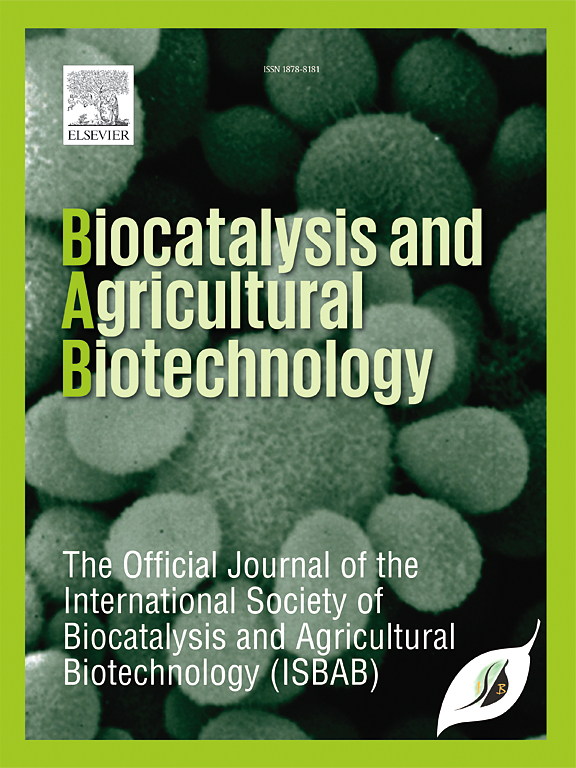First derivative of Gompertz equation: Identification of substrate fractions in psychrophilic anaerobic digestion
IF 3.4
Q2 BIOTECHNOLOGY & APPLIED MICROBIOLOGY
引用次数: 0
Abstract
The biochemical methane potential (BMP) test is widely used to model methane production from organic wastes during anaerobic digestion (AD), often with the Modified Gompertz (MG) kinetic model. Further analysis of the MG model can provide critical insights into the hydrolysis and methanogenic stages of AD. While BMP tests are traditionally conducted at mesophilic temperatures, conducting them at the inoculum source temperature has been recommended. This study evaluated the BMP of waste activated sludge (WAS), organic kitchen waste (OKW), and two co-digestion ratios (Co-D1: 65/35 % OKW/WAS; Co-D2: 35/65 % OKW/WAS) at a psychrophilic temperature of 20 °C. A novel spreadsheet-based approach utilizing the first derivative of the Gompertz equation identified substrate fractions, kinetic constants and AD stages insights. Co-digestion prevented media acidification and enhanced methane yields, with Co-D2 producing 261.0 mLCH4/g-VSadd—significantly higher than WAS (192.8) and OKW (81.2). These yields are comparable to those from similar substrates under mesophilic conditions (35–37 °C), underscoring the energy potential of psychrophilic co-digestion. The kinetic constants achieved coefficients of determination exceeding 0.90. The first derivative method identified two substrate fractions: readily and slowly biodegradable organic matter. This research provides new insights into anaerobic microbial dynamics and substrate degradation pathways, demonstrating the effectiveness of psychrophilic co-digestion for methane production.

Gompertz方程的一阶导数:嗜湿厌氧消化中底物组分的鉴定
生物化学甲烷势(BMP)测试被广泛用于模拟有机废物厌氧消化(AD)过程中甲烷的产生,通常采用修正的Gompertz (MG)动力学模型。对MG模型的进一步分析可以为AD的水解和产甲烷阶段提供关键的见解。虽然BMP测试传统上是在中温环境下进行的,但建议在接种物源温度下进行。本研究评估了废活性污泥(WAS)、有机厨余垃圾(OKW)和两种共消化比(Co-D1: 65/ 35% OKW/WAS;Co-D2: 35/ 65% OKW/WAS),在20℃的亲湿温度下。一种基于电子表格的新方法利用Gompertz方程的一阶导数确定了底物组分、动力学常数和AD阶段。共消化抑制了培养基酸化,提高了甲烷产量,Co-D2的甲烷产量为261.0 mLCH4/g- vsad,显著高于WAS(192.8)和OKW(81.2)。这些产率与类似底物在中温条件下(35-37°C)的产率相当,强调了亲冷共消化的能量潜力。动力学常数的测定系数大于0.90。一阶导数法鉴定出两种底物组分:易降解和缓慢可生物降解的有机物质。这项研究为厌氧微生物动力学和底物降解途径提供了新的见解,证明了亲冷共消化对甲烷生产的有效性。
本文章由计算机程序翻译,如有差异,请以英文原文为准。
求助全文
约1分钟内获得全文
求助全文
来源期刊

Biocatalysis and agricultural biotechnology
Agricultural and Biological Sciences-Agronomy and Crop Science
CiteScore
7.70
自引率
2.50%
发文量
308
审稿时长
48 days
期刊介绍:
Biocatalysis and Agricultural Biotechnology is the official journal of the International Society of Biocatalysis and Agricultural Biotechnology (ISBAB). The journal publishes high quality articles especially in the science and technology of biocatalysis, bioprocesses, agricultural biotechnology, biomedical biotechnology, and, if appropriate, from other related areas of biotechnology. The journal will publish peer-reviewed basic and applied research papers, authoritative reviews, and feature articles. The scope of the journal encompasses the research, industrial, and commercial aspects of biotechnology, including the areas of: biocatalysis; bioprocesses; food and agriculture; genetic engineering; molecular biology; healthcare and pharmaceuticals; biofuels; genomics; nanotechnology; environment and biodiversity; and bioremediation.
 求助内容:
求助内容: 应助结果提醒方式:
应助结果提醒方式:


